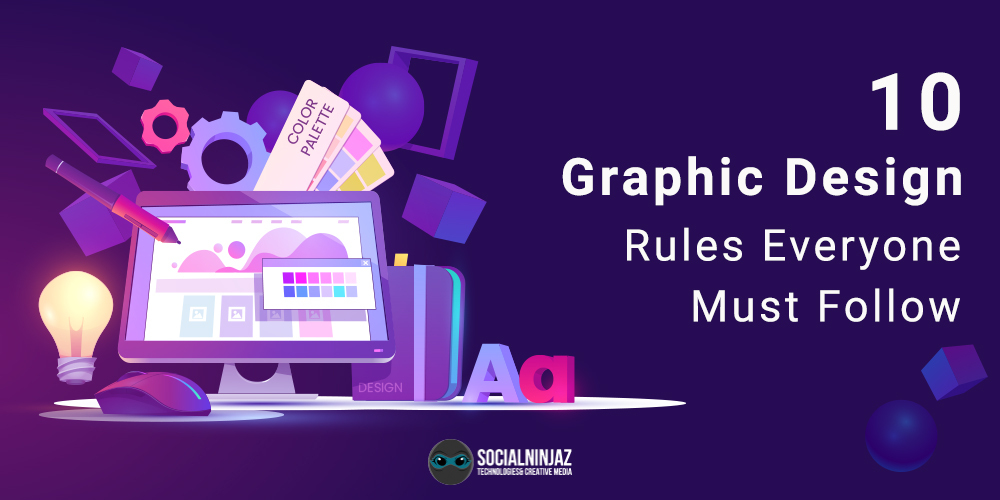Blog

10 Graphic Design Rules Everyone Must Follow
Graphic design is an essential part of any business or brand. It is the visual representation of your company, and it helps establish your brand identity and set you apart from the competition. But with so many different design elements and techniques to consider, it can be overwhelming for beginners to know where to start. Whether designing a logo, creating a website, or developing marketing materials, it is essential to follow some rules and principles to ensure that your designs are successful and professional.
That is why it is critical to follow some basic graphic design rules. These principles will assist you in developing consistent and functional designs that speak to your target audience and convey the appropriate message.
Here are 10 graphic design rules that everyone must follow:
Table of Contents
ToggleUse a consistent color scheme
In graphic design, color is the most powerful tool. It can elicit emotions, convey a message, and influence purchasing decisions. It is critical to select a consistent color scheme for your company to identity and use it throughout your projects.
Choose the right font
Fonts are essentially the voice of your design. They may transmit a wide range of tones and features, so choosing the right one for your brand is crucial. Select a few fonts that complement one another and use them frequently in your projects.
Use whitespace effectively
Whitespace, also known as negative space, is the empty space in a design. It’s not just a blank canvas; it is an integral part of the design that helps to balance and organize the elements. Use whitespace to your advantage by allowing it to highlight important information and create a visually pleasing composition.
Use hierarchy to guide the viewer
Hierarchy is how you arrange the elements in your design to show the importance of each one. By using different font sizes, colors, and styles, you can guide the viewer’s eye to the crucial information first.
Keeping it simple
Simplicity is crucial in graphic design. Too many elements can clutter and distract the viewer, making it difficult for them to understand the message. Maintain a clean and simplistic design by using only the essential elements to convey the message.
Use grid-based layouts
Grid-based layouts help to create a cohesive and organized design. They provide a structure for your elements, making it easy to balance and align. Planning out your grid before starting the design process is essential to ensure a clean and professional result.
Use contrast to draw attention
Contrast is the difference between two elements. It can be color, size, or style. It helps to draw the audience’s attention to specific areas of the design. And can also highlight the hierarchy of the elements.
Stay true to your Brand Identity
Your brand identity is the essence of your company and should reflect in all your designs. Consistency is key to maintaining a powerful brand identity, so make sure you use the same color scheme, fonts, and overall aesthetic in all your designs.
Keep it legible
It doesn’t matter how visually stunning your design is if it’s difficult to read or understand. Use a legible font with sufficient contrast to ensure that the text is easily readable.
Test your designs
It is critical to test any design before finishing it to ensure its effectiveness. Show it to a few people and solicit input on what is working and what isn’t. It will help you fine-tune your design and make it the best.
In conclusion
These ten graphic design rules are essential for creating professional and impressive designs. Following these principles, you can create cohesive and effective projects that speak to your target audience and convey the right message. Whether you are a beginner or an experienced designer, it is essential to keep these rules in mind to ensure that your designs are successful.
admin
Don’t forget to share this post
Similar posts
Why Hiring a WordPress Website Designer Is a Smart Move for Your Business
How Startups Can Leverage Branding Through Social Media for Faster Recognition
How a Web Development Agency Drives SEO, UX, and Long-Term ROI
Building Website for Business vs Relying on Social Media: What Works Best
Marketing Your Business on Social Media – Strategies That Actually Work in 2025
Why You Should Hire a Website Development Agency to Scale Your Business in 2025
Why Your Brand Needs Professional Website Development Services Today
How Web Development Services Empower Brands to Lead in the Digital Age
Why Your Brand Needs a Human-Centric Social Media Marketing Agency
How Does SEO-Friendly Website Design Boost Traffic?
Digital Marketing Using Social Media: What Google’s Latest Update Means for Your Brand in 2025
Why Website Design and Development Services Drive Business Growth
Mastering Social Media Branding: What 2025’s Boldest Indian Brands Are Doing Differently
Why Website Development Services Are Essential for Small Business Growth
Why Hiring a Website Development Agency Is the Smartest Move for Your Business
Janta Sab Jaanti Hai… Par Bhushan Behtar Bechta Hai!!!
What’s the Fuss about Twitter Verification
ChatGPT: The Latest Threat to Human Employment
Difference between a Website and Web Application
Unmasking the Dark Side of SEO: Balancing the Risks and Rewards of Black Hat SEO vs White Hat SEO
Most Suitable Ads for my Business: Search Ads VS Display Ads
Top SEO Websites in the World
How to Get Instagram Verification Blue Tick???
Introduction to Proximity Marketing
YouTube Marketing: Boost Your Online Presence
Off-Page SEO: A Comprehensive Guide
Yoast SEO VS Rank Math SEO
Why Content is King in Modern On-Page SEO
Remarketing 101
Shopify VS WordPress: Which one is more suitable for your business?
Affiliate Marketing 101: Benefits and How to get started
Instagram Stories vs Snapchat Stories
A journey from 0 to 1000 Instagram followers in 10 days
10 Graphic Design Rules Everyone Must Follow
5 Artificial Intelligence Websites for Higher Productivity
Guide to Understanding Web 3.0 Space
What is Influencer Marketing?
Top 20 Performance Marketing Terms You Must Know
Things to look out for in the Digital Marketing Space in 2023
Mastering the Art of Snapchat Marketing
Unlock the power of Search Engine Optimization
Analyse your blog with these KPIs
The Most Innovative and Memorable Social Media Campaigns of the past two decades




























